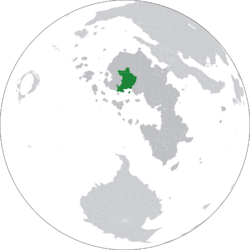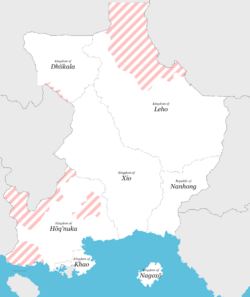Great Xio
Empire of Great Xio Cıoⱶαɴϵ | |
|---|---|
|
Flag | |
 The Empire of Great Xio (dark green) in Aurelia (dark grey) | |
| Capital | Pashae |
| Largest city | Xiseka |
| Official languages | Xi Dialect |
| Recognised national languages | Le, Nūqa, Ka, Huang |
| Recognised regional languages | Soho, Naho, Medhiatei |
| Ethnic groups (2021) | Xieika, Huang, Leika, Nuthan, Kaika, Sohoika, Nahaika, Medhiati |
| Demonym(s) | Xioan |
| Government | Communist Federal Theocracy |
• 77th Mountain Lord | Vosō Ne |
• Elected Grand Syndic | Pakheō-voke Hisema |
• Emperor Absentia | Aidan Redmond |
| Legislature | Imperial Government & Syndic Council |
| Establishment | |
• Xisekan Empire | 430 AD |
• Xi Kingdom | 927 AD |
• Empire of Great Xio | 1731 AD |
| Area | |
• | 784,000 km2 (303,000 sq mi) |
| Population | |
• 2021 census | 8,829,200 |
| GDP (PPP) | 2021 estimate |
• Per capita | 3,575 |
| GDP (nominal) | estimate |
• Per capita | 2100 |
| Currency | Auro (𐠓) |
| Time zone | UTC-4.30 (ALT) |
| Date format | YY/MM/DD |
| Driving side | right |
This article is incomplete because it is pending further input from participants, or it is a work-in-progress by one author. Please comment on this article's talk page to share your input, comments and questions. Note: To contribute to this article, you may need to seek help from the author(s) of this page. |
Great Xio (Xi: Cıoⱶαɴϵ, Xiohane), officially the Empire of Great Xio and informally as Xio, is a nation on the continent of Aurelia bordering Sefesia to the southeast, Proncawi'chi to the northeast, Nuthahan to the west, and the Seylosian city state of Kaseka to the south. The nation is primarily within the western Aurelian Wastes with its borders extending into the Auriel Gulf by the Nagaxō island. Great Xio is a founding member of the Aurelian League having joined since its creation in [TBD]
Inhabited since the first migratory peoples of Aurelia (55kya), the lands that make up Great Xio have seen numerous waves of migratory and colonising people groups resulting in unique phenotypical appearances for numerous Syrbotae groups that inhabit Great Xio and the wider Syrbotae Aurelian Wastes. With the arrival of the Medhiati Aromans, the original Nuthan city states were wiped out through disease and warfare, allowing for the migration of the Syrbotic groups from Dhiikala south into the Xi river valleys and the eventual establishment of the Xi and Le empires.
Seeing colonial powers throughout the 1400s and 1500s, the Syrbotic groups were able to maintain independence through careful political balancing of colonial powers and immunity to non-Aurelian diseases preventing cascading population loss. The modern Great Xio empire rose in the 1720s and 1730s with the consolidation of guilds, tribes, and city states into a cohesive federal state. In the 1970s border conflicts with Sefesia almost led to war however cooler heads prevailed.
In 2012 the annexation of Nagaxō sparked international outrage with Great Xio almost being cut off from the Aurelian League until the establishment of the autonomous region of the Nagaxō Kingdom under the Empire of Great Xio.
Etymology
Xio /ʃiɁo/ comes from old Xi-Le siho ("Land of the Si People") however was recontextualised with the rise of the maritime city of Xiseka ("City of the south") to mean "land of the south(ern) people". Xiohane (Cıoⱶαɴϵ) literally translates to "larger Xio".
In Anglish, Laimiaic, and Mitonese, Xio is either pronounced /ʃio/ or /ʃiho/.
Geography
The Empire of Great Xio is entirely within the desert of the Aurelian Wastes with only the north east of the nation within the Aurelian steppes. The vast majority of the population lives alongside the main rivers in southern Great Xio, making up around 80% of the population, with smaller populations in the desert canyons of Hōq'nuka, the steppe shrublands of Leho, or the mountain valleys of Dhiikala.
WIP
History
WIP
Prehistory (Before 3rd Century AD)
WIP
• Syrbotae non-Syrbotic coastal and river city states.
Syrbotic Migration (3rd Century AD-4th Century AD)
WIP
• Wiped out by Kirvinan colonists and settled by !Greek Ahromans. • Steppe and Mountain Syrbotic groups associated with original modern Syrbotae faith cult migrated south and absorbed the !Greeks.
Tribal Confederacies (430 AD-1520 AD)
WIP
• Syrbotic city states form, Xiseka forms coastal mercantile empire.
Creation of the Empire of Great Xio (1720 AD-1730 AD)
WIP
• Guild system from Mito late 1500s / early 1600s.
• Consolidation of tribes and city states into guilds.
• Previous empires and kingdoms could not achieve the same size as the modern Great Xio due to the unconsolidated tribes and city states. Xiseka was the exception as it was a maritime empire, not a terrestrial one like its descendants.
Early Modern Xio (Mid 16th Century-19th Century)
WIP
• Yellow Empire colonisation on Nanhong
• Seylosian petty lords establishment of the city of Kaseka.
• Seylosian navy forces Yellow Empire to stop expanding its colony to both protect the empire and for its own self interests.
• Xio sells emperor title to Seylos as both a thanks to Seylos for stopping the Yellow Empire but also to end the reign of emperors within Xio.
• Mountain Lord consolidates power, becoming the undisputed head of the empire.
• Mid to late 1700s, annexation of Dhiikala, Khao. Mid 1800s Leho. Late 1800s Hōq'nuka.
Contemporary Period (1900-Present)
WIP
• 1902, contemporary period marked by the introduction of Guild-based representational democracy and the creation of the HoG Grand Syndic title.
• Early 1900s Nanhong falls into debt, sells itself to Great Xio after Fulgistan becomes socialist.
• 1920, Great Xio divides its lands into federal states in the form of the modern day kingdoms and republic of Great Xio.
• Founding member of the Aurelian League at the end of the Thalassan War
• Border conflicts with Sefesia in mid 1900s.
• 2012 annexation of Nagoxō.
Politics
The Empire of Great Xio is divided into 7 federal states of differing autonomy.
| # | Name | Type |
|---|---|---|
| 1 | Xio | Kingdom |
| 2 | Leho | Kingdom |
| 3 | Dhiikala | Oligarchic Theocracy |
| 4 | Hōq'nuka | Kingdom |
| 5 | Khao | Kingdom |
| 6 | Nanhong | Republic |
| 7 | Nagaxō | Autonomous Kingdom |
WIP
Government
WIP
Policy
WIP
Economy
WIP
Culture
WIP
Language
Great Xio is host to numerous different languages, however many of the Syrbotic languages are considered only dialects of the capital Xi dialect. Other languages within the empire are Huang, Nūqa, and the critically endangered Medhiatei within the interior of the island of Nagaxō with an estimated 300 speakers split between 4 villages.
Within Great Xio a modified form of the Laimiaic alphabet, known internally as the Syrbotic Alphabet, is used throughout the nation after being made the official secular script of the empire in 1933.
Religion
WIP
Holidays
WIP

